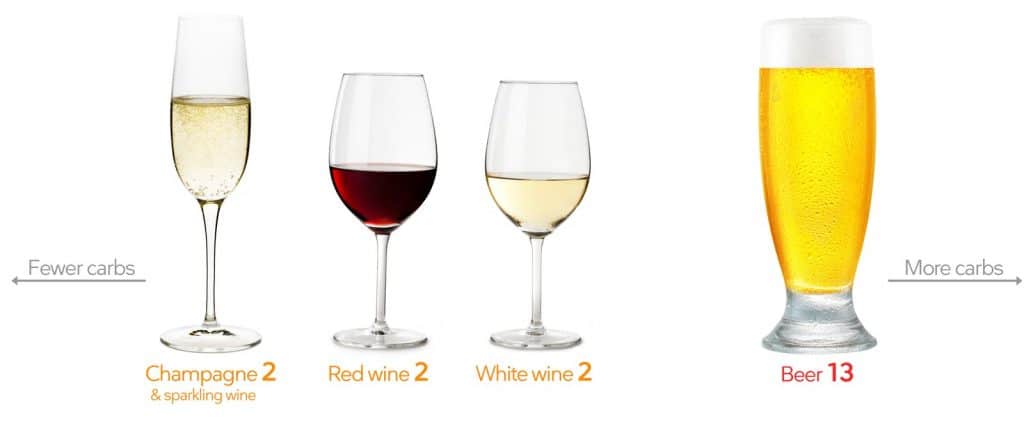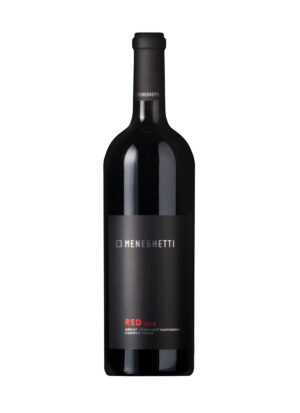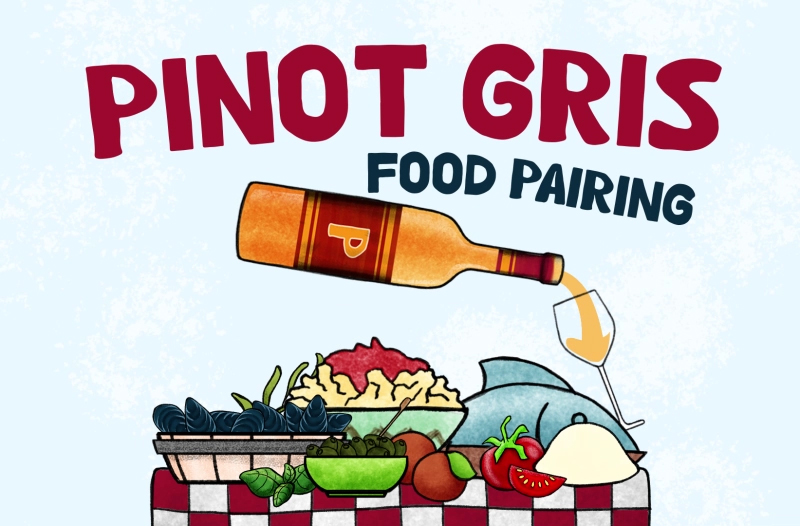What To Drink On a Low-Carb Diet?

Choosing what to drink on a low-carb diet might seem tricky, especially for wine lovers. If you are on a special dieting program, such as Keto or any other low-carb regime, you might find that wines vary greatly in their carb content. Fortunately, there are low-carb wine options available. This article will guide you through understanding the carbs in wine and how to pick the best options for your diet. We’ll cover everything from the carb content of red wines and white wines to estimating carbs in wine. Plus, we’ll offer practical tips on selecting lower-carb wines by learning to read labels and doing some research beforehand.
Key low-carb wine takeaways
- Residual sugar in wine contributes to carbs, and wines with lower sugar content during production have fewer grams of carbohydrates per glass.
- Wine is reasonably low-carb compared to other alcoholic beverages, with distilled spirits being low-carb and cocktails and beer having higher carb content.
- Dry white wines and sparkling wines have lower carb counts compared to full-bodied red wines, making them better options for those watching their carb intake.
- In short, these wines have minimal carbs because they contain less sugar.
- Avoid sweet and dessert wines, as well as wines with added sugars or sweeteners. These can hike up your carb intake quickly.
- Terms to avoid on wine labels for high-carb wines include Süss/Doux, Eiswein or Ice wine, Late Harvest, Dessert Wine, Dolce, Spatlese, Auslese, Demi-sec, Semi-sec, Fortified wine, especially Port, Madeira, Sauternes, and Sherries.
- Terms to choose for low-carb wines include Dry, Sec, Trocken, Brut, and Brut Nature.
- When picking wine on a low-carb diet, always check the label for carb content.
- For those who love bubbles, go for Brut, Extra Brut, or Brut Nature sparkling wines. They have almost no residual sugar and are low in carbs.
- Remember serving size matters; stick to standard 5-ounce or 148 milliliters servings to keep your carb count in check.
Are there any low-carb wines?

The amount of carbs in wine depends on how much sugar is left after fermentation.
During fermentation, yeast turns the sugars from grapes into alcohol. If most or all of the sugars are converted, the wine ends up with low or zero carbs.
Consequently, wines typically contain residual sugars, in varying quantities. However, certain winemaking techniques can reduce the carb content in wines, making them suitable for low-carb diets like keto.
Wines are low-carb beverages in general, but we have to be aware of the fact that when we ingest alcohol, our metabolism works its way to digest it – as soon as possible.
In other words, our body stops the fat-burning processes in order to get rid of the alcohol we consumed. That means that drinking alcohol in excess can stall weight loss.
Note that the sweetness in wines alters the total grams of carbs, so be careful to choose dry versions of wines.
How to calculate carbs in wine
We all want to enjoy a glass of wine without worrying about breaking our low-carb diet. Luckily, figuring out the carb content in your favorite wines is easier than you might think. Here’s how we do it:
- Start by checking the label: Many winemakers now include nutritional information on their bottles. Look for grams of sugar per serving since this will be your main source of carbs.
- Understand the type of wine: Dry wines usually have fewer carbs than sweeter varieties. A good rule of thumb is that the drier the wine, the lower the carbohydrate count.
- Familiarize yourself with common carb counts: Most dry red wines (like Merlot and Cabernet Sauvignon) contain about 2-4 grams of carbs per glass, while dry white wines (such as Chardonnay, Sauvignon Blanc, and Pinot Grigio) might range from 1-2 g carbs per 125ml.
- Use online resources: There are plenty of websites and apps dedicated to providing nutritional details for various types of alcohol, including wine. These can be invaluable tools for those following a keto diet or anyone monitoring their carbohydrate intake closely.
- Estimate based on alcohol content: Generally, higher-alcohol wines have more calories but can sometimes have fewer carbs due to less residual sugar left after fermentation.
- Serving size matters: Standard wine glasses hold about 5 ounces or 148 milliliters, which is considered one serving. Pouring less means consuming fewer carbs, so consider using smaller glasses or limiting yourself to half-pours if you’re trying to keep your carb intake minimal.
- Experiment with brut nature or extra brut sparkling wines: If you enjoy bubbles; these have almost no residual sugar and are among the lowest-carb options available for wine lovers.
Best low-carb wine options
In summary, dry wines are excellent choices for a low-carb diet. These options have minimal carb content and can be enjoyed without derailing your diet plan.
Red low-carb wines
Cabernet Sauvignon, Merlot, and Pinot Noir are great low-carb options. These red wines have minimal carbs and offer a rich, full-bodied flavor. With their reduced glycemic index, they can be enjoyed in moderation as part of a low-carb diet.
Pair them with lean meats or aged cheeses for a delightful experience.
When choosing these red varietals, it’s essential to opt for drier wine varieties to keep the carb count low. Additionally, look for wines with no added sugars or sweeteners to ensure they align with your dietary goals.
White low-carb wines
Now let’s talk about white wines, a delightful choice for those watching their carb intake. With varieties like Chardonnay and Sauvignon Blanc, you can indulge in low-carb elegance.
These dry and crisp options offer minimal impact on your carbohydrate count while still treating your palate to the satisfaction of a beautiful glass of wine.
Consider pairing your meals with these light and refreshing companions for an indulgence that won’t derail your low-carb goals—keeping things light and enjoyable with every sip.
Sparkling wines (Champagne, Prosecco, Cava)
Sparkling wines like dry Champagne, Prosecco and Cava are excellent choices for those on a low-carb diet. These bubbly delights typically have minimal carbs and can be enjoyed in moderation.
Opt for brut varieties or consider brut zero if you prefer drier options, as they tend to have lower sugar content. When selecting sparkling wines, keep an eye out for ones labeled “brut nature” or “extra brut” for the lowest carb options.
By enjoying the crisp effervescence and reduced carb content of these sparkling wines, you’ll keep your carb intake in check.
Can you enjoy alcohol on a low-carb/keto diet?
Moderately yes, but you have to be careful to choose a low-carb alcoholic drink. This includes dry wines, clear spirits like vodka, rum, whiskey, etc.
Be careful about the sugar content, especially in cocktails or some beers that have higher carb content than a glass of wine.
How many carbs does a glass of wine have?
A standard wine serving is 5 oz / 1,5 dcl. A glass of dry red or dry white wine will have 3-4 grams of carbs.
Late-harvested wines, dessert wines and fortified wines like Port have significantly higher levels of carbohydrates – up to 20 grams per serving.
The safest is to stick with dry wines and to watch out for your weight-losing progress.
On the other hand, we are all different and our bodies will respond accordingly.
If you aren’t losing weight, the best is to cut back on alcohol.
Tips for selecting low-carb wines on a diet
- Check the Label: When shopping for wine, check the label for the alcohol by volume (ABV) percentage and the residual sugar (RS) content. Wines with a higher ABV percentage typically have lower residual sugar content.
- Opt for Dry Wines: Dry wines have a minimal amount of residual sugar, making them ideal for those on a low-carb or keto diet. Look for terms such as “dry,” “brut,” or “extra brut” on the label.
- Research Wine Brands: Some winemakers cater specifically to the low-carb market by producing wines with reduced sugar content. Researching and identifying these brands can simplify the selection process.
- Wine Regions: Certain wine regions are known for producing drier-style wines. Examples include Bordeaux in France, Rioja in Spain, and Marlborough in New Zealand. Exploring wines from these regions can increase your chances of finding low-carb options.
- Experiment with Wine Varieties: Don’t be afraid to try different wine varieties to discover your personal preferences. Dry Riesling, Grüner Veltliner, and Tempranillo are a few additional options that can be low in carbs.
Tips on what wine to drink on a low-carb diet
- Understand the carb content: When choosing wine for a low-carb diet, it’s essential to consider the carb content. Dry wines generally have fewer carbs compared to sweet or fortified wines. Look for wines with less than 4 grams of carbs per serving.
- Opt for dry wines: Dry wines typically have lower sugar content and fewer carbs. Examples of dry wines include Sauvignon Blanc, Pinot Grigio, Chardonnay, Cabernet Sauvignon, Pinot Noir, and Merlot. These wines tend to have fewer than 4 grams of carbs per 5-ounce (150 ml) serving.
- Avoid sweet wines: Sweet wines, such as Port, Sherry, Riesling, Moscato, and late-harvest wines, have a higher sugar content and can be higher in carbs. It’s best to avoid them or consume them sparingly if you’re following a low-carb diet.
- Be mindful of Champagne and sparkling wines: Champagne and sparkling wines can vary in carb content. Brut Champagne and dry sparkling wines generally have lower carbs compared to semi-sweet or sweet varieties. Check the label or research the specific brand’s nutritional information to ensure it aligns with your low-carb goals.
- Prioritize red wines: Red wines tend to have slightly lower carb content compared to white wines. They also offer potential health benefits due to their higher antioxidant content. Enjoy red wine options such as Cabernet Sauvignon, Pinot Noir, and Merlot, which are usually lower in carbs.
- Consider lower-alcohol wines: Wines with lower alcohol content often have fewer residual sugars, resulting in fewer carbs. Look for wines with an alcohol content of around 12% or less.
- Moderation is key: While some wines may fit into a low-carb diet, consuming them in moderation is important. Excessive alcohol consumption can hinder weight loss and overall health. Stick to recommended serving sizes, which typically range from 4 to 6 ounces (120 to 180 ml).
- Pair with low-carb foods: When enjoying wine on a low-carb diet, consider pairing it with low-carb foods to maintain balance. Opt for lean proteins, such as grilled chicken or fish, and non-starchy vegetables and salads. This will help keep your overall carb intake in check.
- Stay hydrated: Alcohol can dehydrate the body, so drinking water alongside your wine consumption is crucial. Aim to drink a glass of water for every glass of wine to stay hydrated and prevent the negative effects of dehydration.
- Track your intake: If you’re closely monitoring your carb intake, consider using a food tracking app or website to keep track of your wine consumption. This will help you stay within your desired carb limit and maintain your progress on a low-carb diet.
Conclusion
Finding the perfect drink for a low-carb diet doesn’t have to be a struggle.
Dry whites, dry reds, and certain dry sparkling wines tend to have lower carbohydrate levels, making them great options for low-carb, healthy lifestyles and diet enthusiasts.
By checking labels, researching wine brands, and exploring different wine styles, you can stay true to your dietary goals.
Integrating low-carb wines into daily life requires moderation and mindfulness about serving sizes. We recommend pairing these wines with meals rich in proteins and healthy fats to enhance satiety without compromising carb limits.
Ps. Always consult with a healthcare professional or nutritionist to ensure that wine consumption aligns with your specific dietary needs.
Cheers to finding the perfect low-carb wine to complement your low-carb journey!
You Might Also Like:
- Is Rakija a Croatian National Drink?
- Wine or Wannabe? Truth Behind Alcohol-Free Wine
- Natural Wine 101: Setting the Record Straight
- Best Wine Tours In Croatia
- 7 Most Unique Croatian Vineyards
- Ultimate Travel Guide to Korčula
- Ultimate Travel Guide to Pelješac
- Michelin Star Restaurants in Croatia: Ultimate Guide
- 10 Best Croatian Wine Hotels and Winery Accommodations
- Best Boutique Hotels In Croatia
- Top 6 Eco-Friendly Accommodations in Croatia





